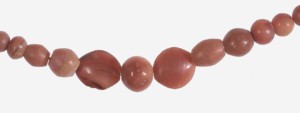 Adjusting the production sequence is a popular way of handling production lines with a product-dependent workload. This post is part of rather long series on Mixed Model Sequencing. In the last post I discussed the basics of sequencing and the calculation of the takt time. This post describes the basics of adjusting workload and buffering – but still for a simple case of only one imbalanced station. Subsequent posts will get more serious with multiple imbalances. But let’s continue with our simple single imbalance example.
Adjusting the production sequence is a popular way of handling production lines with a product-dependent workload. This post is part of rather long series on Mixed Model Sequencing. In the last post I discussed the basics of sequencing and the calculation of the takt time. This post describes the basics of adjusting workload and buffering – but still for a simple case of only one imbalanced station. Subsequent posts will get more serious with multiple imbalances. But let’s continue with our simple single imbalance example.
Logistic
Mixed Model Sequencing – Basic Example Introduction
 Your products may have different work content on your production line, which may make your line less efficient. One possible solution is Mixed Model Sequencing, a way to adjust the sequencing of your products to make the average work content stable. In previous posts I looked at the basics, at how to avoid the problem in the first place and how to play with capacity. However, especially for large complex lines (i.e., automotive), sequencing is often a suitable approach to manage different work contents.
Your products may have different work content on your production line, which may make your line less efficient. One possible solution is Mixed Model Sequencing, a way to adjust the sequencing of your products to make the average work content stable. In previous posts I looked at the basics, at how to avoid the problem in the first place and how to play with capacity. However, especially for large complex lines (i.e., automotive), sequencing is often a suitable approach to manage different work contents.
Mixed Model Sequencing – Adjust Capacity
 Production lines with a product mix may have different workloads at different stations for different products. This can cause waste. In this third post in the series I will look at options on how to adjust the available capacity to ease this problem. In my next post I will look at Mixed Model Sequencing to adjust workload differences.
Production lines with a product mix may have different workloads at different stations for different products. This can cause waste. In this third post in the series I will look at options on how to adjust the available capacity to ease this problem. In my next post I will look at Mixed Model Sequencing to adjust workload differences.
Mixed Model Sequencing – Just Make the Problem Go Away
 Your production line may have different workloads for different product variants. This unevenness causes waste and overburden. In this series of posts I will look at ways to address this unevenness. The first post was an introduction to the topic. This second post will look at ways to simply eliminate the problem – although this may not be feasible for many cases. In the next posts I will look at adjusting the capacity and finally at adjusting the product sequence through Mixed Model Sequencing.
Your production line may have different workloads for different product variants. This unevenness causes waste and overburden. In this series of posts I will look at ways to address this unevenness. The first post was an introduction to the topic. This second post will look at ways to simply eliminate the problem – although this may not be feasible for many cases. In the next posts I will look at adjusting the capacity and finally at adjusting the product sequence through Mixed Model Sequencing.
Mixed Model Sequencing – Introduction
 In a mixed model production line, different products may have different work content at different stations. Hence, some stations may need a longer or shorter time depending on the product. This requires careful planning of the assembly line. If this is not taken into account, it may cause significant idle time with all stations along the line. This is the first of a (very) long series of posts looking at Mixed Model Sequencing (i.e., the behavior of unbalanced workloads, and different ways to address these issues).
In a mixed model production line, different products may have different work content at different stations. Hence, some stations may need a longer or shorter time depending on the product. This requires careful planning of the assembly line. If this is not taken into account, it may cause significant idle time with all stations along the line. This is the first of a (very) long series of posts looking at Mixed Model Sequencing (i.e., the behavior of unbalanced workloads, and different ways to address these issues).
Maintaining Weak FIFO in Parallel FIFO Lanes
 Sometimes you would like to put more material in a single FIFO lane than the space you have available. In this case you would have to use a combination of two or more parallel FIFO lanes. In my last post I described how to maintain a strict FIFO sequence in parallel lanes. This post looks at an easier but less accurate method.
Sometimes you would like to put more material in a single FIFO lane than the space you have available. In this case you would have to use a combination of two or more parallel FIFO lanes. In my last post I described how to maintain a strict FIFO sequence in parallel lanes. This post looks at an easier but less accurate method.
Point-of-Use Provider Routing

This is my last post of a series of three posts on point-of-use providers (also known as mizusumashi, water strider, or water spider). In this post I will go into much more detail on the routing of the point-of-use provider. A less-busy point-of-use provider can handle multiple lines. Similarly, very busy lines may have multiple point-of-use providers. Here I will show you some more details on these possibilities.
Point-of-Use Provider Calculations
 In this second post of my series on point-of-use providers (also known as Mizusumashi, water strider, or water spider), I will discuss the calculation of the workload for the point-of-use provider … although calculation is a way-too-big word for what is, in practice, guesswork with limited data of low quality. However, I hope it helps you with planning your point-of-use providers.
In this second post of my series on point-of-use providers (also known as Mizusumashi, water strider, or water spider), I will discuss the calculation of the workload for the point-of-use provider … although calculation is a way-too-big word for what is, in practice, guesswork with limited data of low quality. However, I hope it helps you with planning your point-of-use providers.
